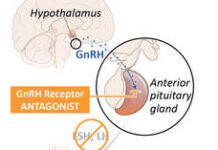In GLOW, a global, randomised, double-blind, phase III study, the addition of zolbetuximab to first-line treatment with CAPOX significantly improved progression-free survival (PFS) and overall survival (OS) compared to placebo plus CAPOX among the patients with claudin-18 isoform 2 (CLDN18.2)-positive, HER2-negative, locally advanced unresectable or metastatic gastric or gastro-oesophageal junction adenocarcinoma.
These results further confirm the survival benefits observed in the phase III SPOTLIGHT study. Together, these studies support the consideration of biomarker testing for tumour expression of CLDN18.2 and the use of zolbetuximab as a first-line treatment in combination with chemotherapy as a new potential standard of care in this biomarker-selected patient population. The findings are published by Prof. Rui-Hua Xu of the State Key Laboratory of Oncology in South China, Collaborative Innovation Center for Cancer Medicine, Sun Yat-Sen University Cancer Center in Guangzhou, China, and colleagues on 31 July 2023 in the Nature Medicine.
The authors wrote in the background that FOLFOX and CAPOX are accepted standard first-line chemotherapy regimens for patients with HER2-negative, locally advanced unresectable or metastatic gastric or gastro-oesophageal junction adenocarcinoma, although oral regimens are more convenient and preferred in Asia. However, patients receiving standard oxaliplatin-based doublet regimens survive approximately 1 year. The combination of targeted therapies or immunotherapies with chemotherapy improve OS in some patients with metastatic disease.
CLDN18.2 is a tight junction protein exclusively expressed in normal gastric mucosa cells and is retained in most gastric or gastro-oesophageal junction adenocarcinomas. In normal gastric mucosa, CLDN18.2 is typically buried within tight junctions. During malignant transformation, loss of gastric mucosa cell polarity may result in CLDN18.2 becoming more exposed and, thus, accessible to therapeutic antibodies. Zolbetuximab is a first-in-class immunoglobulin G1 monoclonal antibody that targets CLDN18.2 and mediates antibody-dependent cellular cytotoxicity and complement-dependent cytotoxicity in CLDN18.2-positive gastric or gastro-oesophageal junction adenocarcinoma cells.
The phase IIb FAST study demonstrated that the combination of zolbetuximab plus chemotherapy prolonged PFS and OS when compared with chemotherapy alone; the benefit was further enhanced in patients whose tumours had higher expression of CLDN18.2. Primary results of SPOTLIGHT, a global, phase III study conducted in patients with CLDN18.2-positive (defined as ≥75% of tumour cells with moderate-to-strong CLDN18 membranous staining), HER2-negative disease demonstrated that both PFS and OS were significantly prolonged in patients treated with first-line zolbetuximab plus a modified FOLFOX regimen (mFOLFOX6) compared with placebo plus mFOLFOX6.
The GLOW study was conducted simultaneously with SPOTLIGHT to confirm the efficacy of the addition of zolbetuximab to chemotherapy in the first-line setting and to examine the addition of zolbetuximab with an alternative first-line chemotherapy backbone that has a different schedule and toxicity profile. According to study investigators, it was appropriate to assess the combination of zolbetuximab with mFOLFOX6 or CAPOX in patients from different geographic regions where one or the other chemotherapy regimen may be preferred.
In the latest article published in the Nature Medicine, the authors report the results from the primary analysis of GLOW, which evaluated the efficacy and safety of first-line treatment with zolbetuximab plus CAPOX in patients with CLDN18.2-positive, HER2-negative, locally advanced unresectable or metastatic gastric or gastro-oesophageal junction adenocarcinoma.
A total, 507 patients were randomised 1:1 to zolbetuximab plus CAPOX or placebo plus CAPOX. GLOW met the primary endpoint of PFS with median 8.21 months versus 6.80 months with zolbetuximab plus CAPOX versus placebo plus CAPOX (hazard ratio [HR] 0.687, 95% confidence interval [CI] 0.544–0.866; p = 0.0007) and key secondary endpoint of OS with median 14.39 months versus 12.16 months (HR 0.771; 95% CI 0.615–0.965; p = 0.0118).
Grade ≥3 treatment-emergent adverse events (TEAEs) were similar with zolbetuximab (72.8%) and placebo (69.9%). The most common grade ≥3 TEAEs were vomiting (12.2% versus 3.6%), anaemia (10.6% versus 11.2%), neutrophil count decreased (10.2% versus 9.6%) and nausea (8.7% versus 2.4%).
In patients with prior gastrectomy, as either TEAEs or treatment-related adverse events (TRAEs), there was a more than 10% difference in the incidence of vomiting, but not nausea in the zolbetuximab compared with the placebo arm, whereas, in patients without prior gastrectomy, there was a more than 10% difference in the incidence of both nausea and vomiting in the zolbetuximab arm compared with the placebo arm. In patients receiving zolbetuximab, but not in patients receiving placebo, nausea and vomiting as TEAEs or as TRAEs were more frequent in patients without prior gastrectomy.
TRAEs led to discontinuation of zolbetuximab in 7.1% patients versus discontinuation of placebo in 4.4% patients. Grade 5 TRAEs occurred in 2.4% patients receiving zolbetuximab versus 2.8% patients receiving placebo.
GLOW demonstrated that CLDN18.2 is a prevalent biomarker in HER2-negative, locally advanced unresectable or metastatic gastric or gastro-oesophageal junction adenocarcinoma. Targeting of CLDN18.2 with zolbetuximab may fulfill an unmet need among a subset of HER2-negative patients. The authors concluded that zolbetuximab plus CAPOX represents a potential new first-line treatment for patients with CLDN18.2-positive, HER2-negative, locally advanced unresectable or metastatic gastric or gastro-oesophageal junction adenocarcinoma.
The study was funded by Astellas Pharma Inc. CLDN18 project team at Roche Tissue Diagnostics collaborated in assay development.
Reference
Shah MA, Shitara K, Ajani JA, et al. Zolbetuximab plus CAPOX in CLDN18.2-positive gastric or gastroesophageal junction adenocarcinoma: the randomized, phase 3 GLOW trial. Nature Medicine; Published online 31 July 2023. DOI: https://doi.org/10.1038/s41591-023-02465-7







